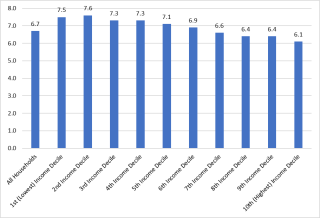Targeted Measures for Low Income Households needed to tackle Cost of Living Crisis

New data from the CSO looking at the impact of inflation by household characteristics showed that the worst impact of the current cost of living crisis was being felt by low-income households, households in rural areas, older people, and those living alone. While annual inflation to March 2022 rose by 6.7 per cent across the State, households in the bottom 10 per cent of income distribution experienced an increase of 7.5 per cent; rural households experienced an increase of 7.3 per cent; households headed by someone aged 65+ experienced an increase of 7.2 per cent; and single-adult households experienced an increase of 7.7 per cent.
While inflation has impacted all households, requiring greater investment in areas such as housing, childcare, healthcare, and energy, targeted measures are needed to "buffer" these households and ensure that they are prevented from falling deeper into poverty and deprivation.
These data show that, while inflation stood at 6.7 per cent in the year to March 2022, the bottom half of the income distribution saw increases above 7 per cent, while the top ten per cent of income earners experienced an increase of 6.1 per cent (Chart 1).
Chart 1: Estimated Inflation by Equivalised Income Deciles, March 2021 to March 2022 (12 months)

Source: CSO, 2022: Estimated Inflation by Household Characteristics March 2022, www.cso.ie
The main drivers of inflation (besides 'Other') were Transport and Energy Costs, with those in the bottom 50 per cent most impacted by increases in electricity, gas and other fuels (increases from 2.1 to 2.9 per cent across the lower deciles) and those in the top 50 per cent most impacted by increases in transport costs (increases from 2.4 to 2.7 per cent across the upper deciles). Four of the five lower deciles also saw increases in rent by at least 1 per cent (the 5th decile (the 50th per cent) experienced an increase in rent of 0.8 per cent) (Table 1).
Table 1: Contributions to Estimated Inflation classified by Equivalised Gross Household Income Deciles, March 2021 to March 2022 (12 months)
| Type of Household | Food & Non-Alcoholic Beverages | Alcohol Beverages & Tobacco | Rent | Mortgage Interest Payments | Electricity, Gas & other Fuels | Transport | Restaurants & Hotels | Other | Total |
| All Households | 0.4 | 0.4 | 0.7 | 0.1 | 1.9 | 2.4 | 0.5 | 0.3 | 6.7 |
| 1st (Lowest) Income Decile | 0.5 | 0.5 | 1.5 | 0.0 | 2.5 | 1.8 | 0.3 | 0.3 | 7.5 |
| 2nd Income Decile | 0.5 | 0.5 | 1.2 | 0.0 | 2.9 | 1.8 | 0.4 | 0.4 | 7.6 |
| 3rd Income Decile | 0.5 | 0.5 | 1.0 | 0.0 | 2.4 | 2.1 | 0.4 | 0.3 | 7.3 |
| 4th Income Decile | 0.5 | 0.6 | 1.0 | 0.1 | 2.3 | 2.3 | 0.4 | 0.3 | 7.3 |
| 5th Income Decile | 0.4 | 0.5 | 0.8 | 0.1 | 2.1 | 2.4 | 0.4 | 0.4 | 7.1 |
| 6th Income Decile | 0.4 | 0.4 | 0.5 | 0.1 | 1.9 | 2.7 | 0.5 | 0.3 | 6.9 |
| 7th Income Decile | 0.4 | 0.4 | 0.5 | 0.1 | 1.8 | 2.6 | 0.5 | 0.3 | 6.6 |
| 8th Income Decile | 0.3 | 0.4 | 0.4 | 0.1 | 1.7 | 2.5 | 0.6 | 0.3 | 6.4 |
| 9th Income Decile | 0.3 | 0.3 | 0.4 | 0.1 | 1.5 | 2.7 | 0.6 | 0.4 | 6.4 |
| 10th (Highest) Income Decile | 0.3 | 0.3 | 0.4 | 0.2 | 1.4 | 2.4 | 0.8 | 0.4 | 6.1 |
Source: CSO, 2022: Estimated Inflation by Household Characteristics March 2022, www.cso.ie
Housing Tenure
Increases in inflation are also felt differently depending on whether the home is owner occupied or rented. As may be expected, renters have experienced a higher rate of inflation than the general population (an increase of 7 per cent in the private rented sector and 7.3 per cent in Local Authority accommodation), however owners with a mortgage had a lower than average inflation rate (6.3 per cent).
The main contributor to inflation for renters in the private rented sector was their rent (increasing by 2.6 per cent), while owner occupiers with a mortgage saw an increase in their mortgage interest payments by just 0.3 per cent. Once again, across all tenure types, energy and transport were the main drivers of inflation. Energy costs increased by 2.4 per cent for owner occupiers and Local Authority tenants, while increases in transport costs for owners with and without a mortgage was 2.6 and 2.7 per cent respectively. This compares to 1.5 and 1.7 per cent respectively for Local Authority tenants and renters in the private rented sector (Table 2).
Table 2: Contributions to Estimated Inflation classified by Household Tenure March 2021 to March 2022 (12 months)
| Type of Household | 01. Food & Non-Alcoholic Beverages | 02. Alcohol Beverages & Tobacco | 04.1 Rent | 04.2 Mortgage Interest Payments | 04.5 Electricity, Gas & other Fuels | 07. Transport | 11. Restaurants & Hotels | Other | Total |
| All Households | 0.4 | 0.4 | 0.7 | 0.1 | 1.9 | 2.4 | 0.5 | 0.3 | 6.7 |
| Owned Outright | 0.4 | 0.4 | 0.0 | 0.0 | 2.4 | 2.7 | 0.6 | 0.5 | 7.0 |
| Owned with Mortgage | 0.4 | 0.4 | 0.0 | 0.3 | 1.7 | 2.6 | 0.6 | 0.4 | 6.3 |
| Rented from Local Authority | 0.5 | 0.7 | 1.6 | 0.0 | 2.4 | 1.5 | 0.3 | 0.3 | 7.3 |
| Rented from Private Owner | 0.3 | 0.4 | 2.6 | 0.0 | 1.5 | 1.7 | 0.4 | 0.1 | 7.0 |
Source: CSO, 2022: Estimated Inflation by Household Characteristics March 2022, www.cso.ie
Age of Reference Person
Households were the reference person was aged 65+ had an inflation rate of 7.2 per cent, compared to the 6.7 per cent for households with a reference person aged 35-64, and 6.6 per cent for younger households aged under 35. The difference here was mainly driven by energy costs, with the cost of electricity, gas and other fuels increasing by 2.8 per cent for older households, compared to less than 2 per cent for others (Table 3).
Table 3: Contributions to Estimated Inflation classified by Age of the Household Reference Person March 2021 to March 2022 (12 months)
| Type of Household | Food & Non-Alcoholic Beverages | Alcohol Beverages & Tobacco | Rent | Mortgage Interest Payments | Electricity, Gas & other Fuels | Transport | Restaurants & Hotels | Other | Total |
| All Households | 0.4 | 0.4 | 0.7 | 0.1 | 1.9 | 2.4 | 0.5 | 0.3 | 6.7 |
| Reference Person aged under 35 | 0.3 | 0.3 | 1.9 | 0.1 | 1.4 | 2.0 | 0.5 | 0.1 | 6.6 |
| Reference Person aged 35 to 64 | 0.4 | 0.4 | 0.5 | 0.1 | 1.9 | 2.5 | 0.5 | 0.3 | 6.7 |
| Reference Person aged 65 or over | 0.5 | 0.4 | 0.2 | 0.0 | 2.8 | 2.3 | 0.5 | 0.5 | 7.2 |
Source: CSO, 2022: Estimated Inflation by Household Characteristics March 2022, www.cso.ie
Household Composition
Single-adult households had the highest rate of inflation in the year to March 2022, at 7.7 per cent, followed by single-parent households at 7.2 per cent. While the main driver for single adult and single-parent households was energy costs (increased by 2.8 and 2.3 per cent respectively in the year to March 2022), for single-parent households, rent increases were also a significant factor (increased by 2 per cent) as further demonstrated in our latest Housing Costs and Poverty 2022 briefing which showed that single parent households experienced a poverty rate of 51 per cent after housing costs had been factored in. Transport costs were more of an issue for single adult households than single-parents (2.1 per cent compared to 1.4 per cent) (Table 4).
Table 4: Contributions to Estimated Inflation by Household Composition March 2021 to March 2022 (12 months)
| Type of Household | Food & Non-Alcoholic Beverages | Alcohol Beverages & Tobacco | Rent | Mortgage Interest Payments | Electricity, Gas & other Fuels | Transport | Restaurants & Hotels | Other | Total |
| All Households | 0.4 | 0.4 | 0.7 | 0.1 | 1.9 | 2.4 | 0.5 | 0.3 | 6.7 |
| 1 adult | 0.3 | 0.5 | 0.9 | 0.1 | 2.8 | 2.1 | 0.5 | 0.4 | 7.7 |
| 1 adult with children | 0.4 | 0.5 | 2.0 | 0.1 | 2.3 | 1.4 | 0.3 | 0.3 | 7.2 |
| 2 adults | 0.4 | 0.5 | 0.6 | 0.1 | 2.1 | 2.4 | 0.6 | 0.3 | 6.9 |
| 2 adults with 1 to 3 children | 0.4 | 0.3 | 0.7 | 0.2 | 1.8 | 2.4 | 0.5 | 0.4 | 6.6 |
| 3 plus adults | 0.4 | 0.4 | 0.5 | 0.1 | 1.6 | 2.6 | 0.6 | 0.2 | 6.5 |
| Other households with children | 0.4 | 0.4 | 0.5 | 0.1 | 1.8 | 2.4 | 0.4 | 0.4 | 6.3 |
Source: CSO, 2022: Estimated Inflation by Household Characteristics March 2022, www.cso.ie
Social Justice Ireland Recommendations
Linking supports to existing social transfers, such as recent changes to the winter fuel allowance, or assisting lower-income groups in other ways, will target the groups most affected by recent price increases.
Social Justice Ireland proposed two practical measures to Government to reduce the cost of living for low income households; benchmarking core social welfare rates to 27.5 per cent of average weekly earnings and making the two main tax credits refundable. These policies would directly assist people on fixed incomes and people in low paid employment who are most impacted by the rising cost of living. In our response to the package of measures to deal with the cost of living announced by Government on 10th February, we noted that the bulk of the funding available (€378m) went on a universal energy credit, rather than on measures to target low income and rural households who have been most impacted by increasing energy prices. A more appropriate use of the €378m allocated to the universal energy credit would have been to implement the OECD recommendation to redesign the fuel allowance, delink it from heating fuels, update and expand the eligibility criteria and provide it to eligible households during the whole year. This would provide a tool for Government to target and support rural and low income households (those impacted most by inflation) now and in the years ahead as policies to meet the targets set out in the carbon budgets are implemented.
We also need to address universal issues such as the affordability of housing and childcare, by providing good quality infrastructure and services.